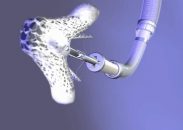With an approximate incidence of 0.05% to 0.25%, post-acute myocardial infarction (AMI) mitral valve failure caused by papillary muscle rupture is not exactly common. However, it is associated to high mortality rate, ranging between 36% and 80%. Current guidelines recommend surgical treatment, but more often than not surgery involves prohibitive or extremely high risk, with…
Mitral Trial: 2-Year Followup
At present, an important group of patients with mitral valve disease are at high surgical risk, especially those with deteriorated bio-prosthesis, severe mitral annulus calcification or those who had received mitral annuloplasty. Percutaneous treatment with balloon expandable valves is a valid option to treat these patients, seeing as their 30 day and one-year outcomes look…
SOLACI-SOCIME 2022 | When is indicated the transcatheter treatment of mitral regurgitation
Read the most outstanding articles from the first day of the SOLACI-SOCIME 2022 Congress. In this case, consult the presentation by Dr. Márcio Montenegro, entitled “When is indicated the transcatheter treatment of mitral regurgitation”
SOLACI-SOCIME 2022 | Tricuspid Edge-to-edge repair. When the Triclip is indicated?
Read the most outstanding articles from the first day of the SOLACI-SOCIME 2022 Congress. In this case, consult the presentation by Dr. Luis Marroquín, entitled “Tricuspid Edge-to-edge repair. When the Triclip is indicated?”
The Best of the SOLACI-SOCIME 2022 Main Arena: Mitral Valve
During the “Mitral Valve” session (on the first day of the SOLACI-SOCIME 2022 Congress), Dr. Ignacio Amat Santos (SPA) delivered a great talk on transcatheter mitral valve replacement (TMVR). During his presentation, he discussed different scenarios for transcatheter replacement: mitral valve-in-vale, mitral valve-in-ring, mitral valve in MAC, and new devices for non-calcified native valves. When…
Post-MitraClip Mitral Valve Stenosis: Bad Prognosis
The EVEREST II trial has shown the MitraClip has similar mortality rate to that of surgery and, on the other hand, we are well aware that residual mitral regurgitation (MR) is associated with a strong negative impact. However, research has shown little about transvalvular gradient after MitraClip and what it entails. 268 patients receiving MitraClip were…
MitraClip Reduces Renal Function Deterioration
Severe mitral regurgitation is associated to cardiac failure and hospitalization and over time is accompanied by kidney failure, which leads to higher mortality. In the COAPT study, in patients with low ejection fraction, MitraClip showed benefits over medical treatment, but there was an important group of people with kidney function deterioration. The evolution and benefit…
Is High Mean Gradient After Edge-to-Edge Strategy Important?
Edge-to-edge treatment of the mitral valve is currently a valid alternative to surgery in cases of mitral regurgitation. Different studies have taken residual mitral regurgitation as a parameter of success, but little research has been conducted on the residual gradient once the procedure has been completed. What has been published is that a mean gradient…
Transcatheter Edge-To-Edge Repair Is Favorable for Elderly Patients at High Surgical Risk
Mitral valve prolapse is the most frequent cause of mitral valve regurgitation and is associated to hospitalization for cardiac failure and mortality. At present, the preferred treatment for operable patients is mitral valve surgical repair. Transcatheter edge to edge repair (TEER) has shown great benefit patients at high surgical risk; however, it has not been…
Is Increased Mitral Valve Gradient After MitraClip a Long-Term Prognostic Factor?
Transcatheter mitral valve repair using the edge-to-edge strategy has become a therapeutic alternative for patients with severe primary mitral valve regurgitation (MVG) who are at high or extreme surgical risk. However, both degree of residual regurgitation and gradient after the procedure should be taken into account, as in previous studies the latter was associated with…







